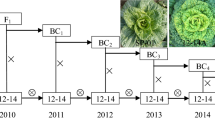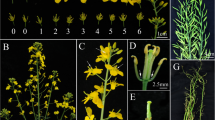Abstract
Male sterility (MS) has been studied intensively in Brassica crops to ensure high purity and the protection of F1 hybrids. In the preceding trial, broccoli microspores were treated with a mutagen, n-nitroso-n-methyl urethane (NMU), during the cultural process to produce MS. Many MS plants were derived from the 0.01 μM and 0.1 μM treatments just before and at the fourth day of culture, respectively. In this study, most MS plants inherited sterility from a single recessive gene. Only one plant, 9-4C-106, which originated from the 0.1 μM treatment on the fourth day, was controlled by a single dominant gene. Another dominant mutant gene suppressing the expression of this dominant MS gene was discovered in a plant treated with 0.01 μM NMU. A hybrid breeding system using this MS structure is discussed.
Similar content being viewed by others
Literature Cited
Anderson, W.C. and J.B. Carstens. 1977. Tissue culture propagation of broccoli, Brassica oleracea (Italica group), for use in F1 hybrid seed production. J. Amer. Soc. Hort. Sci. 102:69–73.
Bannerot, H., L. Loulidard, and T. Tempe. 1974. Cytoplasmic male sterility transfer from Raphanus sativus to Brassica, p. 52–54. In: Eucarpia-Cruciferae Conference. Scottish Hort. Res. Inst., Dundee, Scotland.
Cardi, T. and E.D. Earle. 1997. Production of new CMS Brassica oleracea by transfer of ‘Anand’ cytoplasm from B. rapa through protoplast fusion. Theor. Appl. Genet. 94:204–212.
Christey, M.C., C.A. Makaroff, and E.D. Earle. 1991. Atrazine-resistant cytoplasmic male-sterile-nigra broccoli obtained by protoplast fusion between cytoplasmic male-sterile Brassica oleracea and atrazine-resistant Brassica campestris. Theor. Appl. Genet. 83:201–208.
Cole, K. 1959. Inheritance of male sterility in green sprouting broccoli (Brassica oleracea L. var. italica). J. Amer. Soc. Hort. Sci. 95:13–14.
Dunemann, F. and J. Grunewaldt. 1991. Identification of a monogenic dominant male sterility mutant in broccoli (Brassica oleracea var. Italica Plenck). Plant Breeding 106:161–163.
Fang, Z., P. Sun, Y. Liu, L. Yang, X. Wang, A. Hou, and C. Bian. 1997. A male sterile line with dominant gene (Ms) in cabbage (Brassica oleracea L. var. capitata) and its utilization for hybrid seed production. Euphytica 97:265–268.
Jeong, H.W. and S.-S. Lee. 1997. Influence of mutagen, n-nitroso n-methyl urethane on embryo induction and plant development in microspore culture of broccoli. J. Kor. Soc. Hort. Sci. 38:379–383.
Johnson, A.G. 1958. Male sterility in Brassica. Nature 182:1523.
Kao, H.M., W.A. Keller, S. Gleddie, and G.G. Brown. 1992. Synthesis of Brassica oleracea/Brassica napus somatic hybrid plants with novel organelle DNA compositions. Theor. Appl. Genet. 83:313–320.
Kit, C., M.A. C.M. Zaal, and W.H.J. Verbeek. 1993. Analysis of genic male sterility in Brassica oleracea. Euphytica 68:53–57.
Lazzeri, P.A. and J.M. Dunwell. 1986. In vitro regeneration from seedling organs of Brassica oleracea var. italica plenck cv. green comet. II. Effect of light condition and explant size. Ann. Bot. 58:699–710.
Lee, S.-S., J.-H. Kim, and H.-R. Pang. 1993. Culture of flower buds and pedicel non-treated and treated with chemical mutagen in broccoli, Brassica oleracea var. italica. Rep. Food and Resources Institute, Chung-Ang Univ. 5:1–12.
Lee, S.-S. and S.C. Nam. 1995. Microspore culture of broccoli (Brassica oleracea L. var. italica). J. Kor. Soc. Hort. Sci. 36:635–640.
Nieuwhof, M. 1961. Male sterility in some cole crops. Euphytica 10:351–356.
Ogura, H. 1968. Studies on the new male sterility in Japanese radish with special reference to utilization of this sterility toward the practical raising of hybrid seeds. Mem. Fac. Agri. Kagoshima Univ. 6:39–78.
Renard, M., R. Delourme, J. Mesquida, G. Pelletier, C. Primard, L. Boulidard, C. Dore, V. Ruffio, Y. Herve, and J. Morice. 1992. Male sterilities and F1 hybrids in Brassica, p. 107–119. In: Y. Dattee, C. Dumas, and A. Gallais (eds.). Reproductive biology and plant breeding. Springer, Berlin; Heidelberg; New York.
Sigareva, M.A. and E.D. Earle. 1997. Direct transfer of a cold-tolerant Ogura male sterile cytoplasm into cabbage (Brassica oleracea L. var. capitata). Theor. Appl. Genet. 94:213–220.
Takahata, Y. and W.A. Keller. 1991. High frequency embryogenesis and plant regeneration in isolated microspore culture of Brassica oleracea. Plant Sci. 74:235–242.
Yarrow, S.A., L.A. Burnett, R.P. Wildeman, and R.J. Kemble. 1990. The transfer of ‘Polima’ cytoplasmic male sterility from oilseed rape (Brassica napus) to broccoli (B. oleracea) by protoplast fusion. Plant Cell Rpt. 9:185–188.
Author information
Authors and Affiliations
Corresponding author
Rights and permissions
About this article
Cite this article
Kim, J., Lee, SS. Identification of monogenic dominant male sterility and its suppressor gene from an induced mutation using a broccoli (Brassica oleracea var. italica) microspore culture. Hortic. Environ. Biotechnol. 53, 237–241 (2012). https://doi.org/10.1007/s13580-012-0091-6
Received:
Revised:
Accepted:
Published:
Issue Date:
DOI: https://doi.org/10.1007/s13580-012-0091-6




